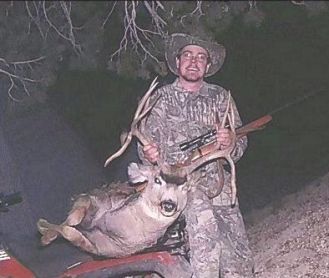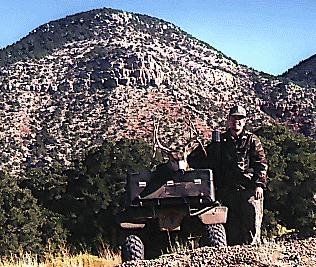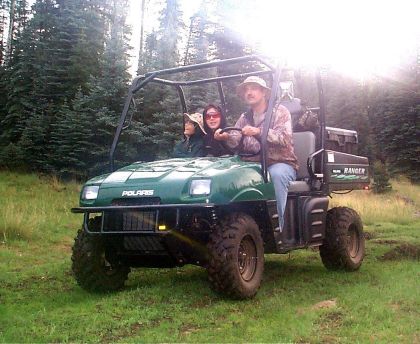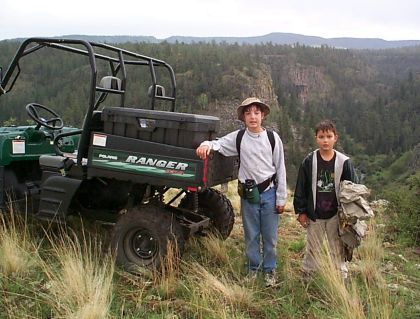I decided to follow a different branch of the rough back road into the
Tumacacori Mountains than I had been using in times past. My traditional
route had one spot that always caused my truck to scrape its frame. The
new route led to a rather nice camp spot, which was about 2 miles away
from the old camp spot on the old route -- and I did not have to scrape
frame to get there.
My eleven year old son Bennet and I were seeking javelina for the next
week in unit 36B. On my last deer hunt here, I had encountered javelina
herds on three separate occasions over the course of a week.
About an hour after setting up at New Camp, a family of hunters, all on
quad ATVs, came rumbling past our camp, but we saw no other trucks come
our way for the next week.
After exploring in all directions from New Camp over several days, we had
yet to lay our eyes on any desert pigs. Oh, we thought we had caught a
whiff of mildly skunky odor one evening, but a quick search before dark,
and a more thorough search the next morning, did not pan out. We also
visited the one javelina herd site that lay between New Camp and Old Camp
-- several times -- but of course they werenít there anymore.
So we decided to walk to Old Camp, because the other two herd sightings
were in the vicinity of Old Camp. Like I said, Old Camp was two miles
away, and since we hunted our way there, it took us until just before
lunchtime to get there. We sat down under an oak, pulled lunch out of
our backpacks and enjoyed a peaceful picnic in the wild.
We then climbed to the nearest high spot to take a look around. After
about 45 minutes of glassing, we realized that we needed to start heading
back to New Camp because the walk back would consume the rest of the
daylight. Though we did make it as far as Herd Site Two, we did not have
the time (or maybe the energy) to press the further mile toward Herd Site
Three.

Hunting With ATVs
Mark Snyder
A while back Dan asked me to write an article about hunting with All
Terrain Vehicles (ATV's) and I finally have gotten around to it. I
have used ATV's on my hunting trips for about ten years now. I love
the freedom they allow in getting from camp to hunting area or from
hunting area to hunting area. I do not own a four-wheel drive vehicle
and usually take my truck and cab-over camper on my hunting trips.
The combination of a cab-over camper and a non-four wheel drive vehicle
can limit you on where you make camp, especially in the desert, or up
in snow country.
One of the things I like about ATV's is that there is no shortage of
accessories, which makes the ATV all the more versatile. I have a gun
boot for holding my shotgun or rifle when I carry them and also gun
racks that I use for my bow when I am hunting with that. My buddy
purchased a hard-sided box to mount on the rear of his and we use this
to carry any extra clothing or hunting accessories along with us.
ATV's can be more comfortable to ride then a vehicle and can usually
get you to your destination quicker, in rough terrain, which there is
no short supply of in this state. However, in colder weather a vehicle
is definitely more comfortable. An example of this is when I hunted in
the Kaibab in late November and the morning temperatures were in the low
thirties. Couple that with the wind chill, which probably put you in
the single digits, on a 15-mile ATV ride and you find out where you are
lacking protection from the weather.
Another nice thing about ATV's is the gas mileage. I do not have an
odometer on mine but I imagine I can get about 40-50 miles to the gallon.
I can usually travel around for three to four days between refills since
I mainly use the ATV to get me as close as possible to my hunting areas
and go out on foot after I park.
Of course, as you all know, they come in various sizes and types. I have
an older model, which is only a two-wheel drive. However, if I were to
purchase another I would get it in four-wheel drive. I have been in some
tough spots and needed help from my buddies to get up some steep trails.
My friend's four wheel drive ATV climbed the obstacles with ease. We have
the four stroke motors since they are a lot quieter which works well for
hunting. Most modern day ATV's have centrifugal clutches or are completely
automatic which makes them very easy to drive especially in steep terrain.
Just last weekend we used the ATV's to set up our tree stands for the
upcoming archery deer and elk seasons. My hunting partner had borrowed
a little trailer to use and it worked really nice for hauling the tree
stands and the equipment to get them installed. They also work very nice
for retrieving your game. I have had the opportunity to carry out a deer
on one and numerous javelina. I have yet to haul out an elk with one but
my brother has done so with his ATV in Idaho.
A side benefit to ATV's is it helps entertain the wife and kids when I am
out archery hunting in the woods. They'll hop on them and go for rides
during the day while I am out hunting or they will give me a ride to an
area where I am going to hunt and come pick me up when the sun goes down
in the evening. Some times I get lucky and they'll have spotted some game
in an area and I'll go hunt that the next day.
They also are fun to take out when you're camping in the woods during the
summer to scout out new areas to hunt. We also like to take them out in
the desert during the cooler months for sightseeing and group excursions.
Game & Fish and Arizona State Parks have a nice pamphlet, which gives a
brief description of some of the laws concerning ATV's and their use in
Arizona's public land and roadways. I recommend you pick one up if you
are interested purchasing an ATV.

|
|
At the first road we hit on the way back, we ran into another hunter on
a quad ATV. We talked a bit, showed him where he was on a topo, and we
bid each other a good hunt.
We stopped and glassed from different vantage points as we hunted back to
camp, again without seeing anything, but this walk back was significant
because itís the first time I really started seriously thinking, "I need
an ATV." If we had an ATV, we could have traveled the distance from New
Camp to Old Camp in minutes, easily negotiating the frame-scrape point.
We would have had all day to explore the vicinity, including Herd Site
Three.
The All-Terrain Utility Vehicle
I knew though, that it would take a different kind of ATV than the common
quad. All quadís are essentially one-man vehicles. I know that some folks
routinely carry a passenger on their quads, but every manufacturer warns
against the practice as being unsafe. But since I have two pre-teen
up-and-coming young hunters, an ATV designed for carrying passengers was
what I needed.
Nobody has yet come up with a name for this class of vehicle that has stuck.
Some names I have seen used by different manufacturers are "Multi-Seat
Cargo Vehicle", "Trail Utility Vehicle", "Super Utility Vehicle", "Off Road
Utility Vehicle", and "All-Terrain Utility Vehicle".
The class was defined by Kawasaki when they introduced their Mule utility
vehicle back around 1989. Since then, a number of manufacturers have
entered this market with similar vehicles. The various manufacturers all
come at the market from different directions. Both the Kawasaki Mule and
the Polaris Ranger entered this market from the ATV direction. The Toro
Twister comes into the market from the riding lawnmower angle. John Deere
brings their Gator to the party from the small tractor and farm implement
market. EZ-Go and Club come to the market from the golf cart world. In
fact, the shorthand description I use when Iím trying to describe this type
of vehicle to someone, is "four wheel drive golf cart".
On the way back from a Woods Canyon fishing trip with the kids, I stopped in
Rye at Four Seasons Motorsports. They let me test drive a Polaris Ranger 4x4
and I was hooked. Although I ultimately bought my Ranger in town at Metro
Motorsports, I recommend that anyone thinking about a Polaris or Yamaha ATV
give Four Seasons a chance. They treated me well and they will even deliver
your ATV to Phoenix if you buy there.
I suppose I must admit that I did not do as much pre-purchase research as I
should have. But post-purchase research only confirmed that I had made the
right decision with the Polaris. Of the vehicles in the class, the Polaris
has the greatest horsepower (30), the most capable suspension system (6+ inches
front and rear), the highest top speed (40 mph -- all the others top out at less
than 25), the greatest load capacity (1500 pounds total, 1000 in the bed), the
greatest towing capacity (1500 pounds), and the greatest seating capacity (3
across).
The Rangerís 4WD system is really a switchable on-demand AWD system. You can
run in AWD all day long, but the front wheels are only engaged when the vehicle
senses slippage in the rear wheels. You can also lock the rear differential
with a dash-mounted locking lever.
Power is fed to the rear wheels through a dual-range Constantly Variable
Transmission (CVT). This is a belt-driven torque converter type automatic
transmission. You are warned that low range is the vehicleís primary driving
range. High range is reserved for hard pack surfaces with a light load.
Lugging the vehicle in high range can lead to belt slippage, belt overheating,
and ultimately drive belt failure. Once you understand the design limitations
of the CVT, youíll learn to choose the right transmission range for the situation.
Low range will take you up to about 18 MPH before the engine starts to feel like
itís revving too high. The entire purpose of the vehicle is to take you places
on roads where 10 mph might toss you out of your seat, so practically speaking,
this is not a limitation.
As mentioned, the Ranger seats three across, and does so comfortably. The Ranger
is about 60" wide, almost as wide as your typical compact car. Itís much shorter
though at 113 inches. I had to get a trailer with internal dimensions of 6 feet
by 10 feet to comfortably fit the Ranger. Polaris says that it will fit in the
bed of a full size pickup with the tailgate down.
The 500cc single cylinder powerplant is located amidships underneath the seat.
The undercarriage is fully protected with a full length composite skid plate.
The machine is braked at all four corners by hydraulic disks (best-in-class
braking system).
The Ranger is equipped with a tilt-down pickup box with a tailgate. The
entire box is made of tough plastic and measures 53"x38"x12" internally.
On our first trip out to the desert with the Ranger, we found that dust
has a way of swirling into the pickup box, so I picked up a large plastic
cargo box with hinged lid (Contico) at Walmart for $35 which I bolted into
the Rangerís box. The Contico box takes up about 40% of the bedís floor
area, but I figure that I could still transport a deer back there.
A full roll cage surrounds the cockpit, but Polarisí lawyers put a statement
into the ownerís manual that says that the roll cage was not designed to
protect the occupants! For ease of manufacture I suspect, the roll cage is
made in several sections. The sections are joined in six locations with pop
rivets. These joints have an annoying habit of squeaking and creaking as you
negotiate road obstacles.
For our second outing with the Ranger, we went up to the White Mountains for
a weekend. Unlike down here in the desert, the White Mountains have been
getting good rain. On both Saturday and Sunday, we were hosed down with
intermittent showers. The good news was the rain quieted down the roll barís
creaking! The water in the joints acted as a lubricant. I think Iíll try
injecting some WD-40 into those joints to see if that helps on dry days.
I swung a deal with Metro Motorsports to buy the Ranger at the same price as
Four Seasonsí out-the-door price, but to toss in two gun boots plus a bed-mount
dual gun boot bracket. Well this wonít work anymore now that Iíve got that
Contico box bolted down back there. What Iíve decided to do is to simply use
standard rectangular hard sided gun cases bungeed to the top of the roll cage.
Exactly where is it legal to run an ATV? The Apache-Sitgreaves National Forest says,
The policy for driving motorized vehicles on this National Forest is tied to
the State of Arizona's motor vehicle policy. On all state, county, and those
forest roads marked by a horizontally-numbered route marker (ie 249), the
motorized vehicle and its driver must be "street legal." On unmarked forest
roads or forest roads that are marked by a vertical route number, the driver
and the vehicle do not need to be licensed. Driving off of forest roads is
not encouraged but may be legal if no damage is done to plants or soils or if
wildlife is not harassed and if a muffler/spark arrestor is in place.
To be considered "street legal," motor vehicles must be registered with the
State and must properly display a registration plate. The State also requires
proof of insurance and that a driver be licensed. Registration and proof of
insurance must be carried with the vehicle. To be "street legal" vehicles
must have the following:
- At least one but not more than two headlights that shine at least 500 feet
- At least one taillight that is visible at least 500 feet to the rear
- Brake light
- License plate securely fastened to the rear of the vehicle and license plate light
- Horn, audible from a distance of at least 200 feet
- Muffler in good working order and in constant operation
- Rearview mirror
To make the Ranger "street legal," I only had to add a rear view mirror,
a horn, and a lighted license plate bracket. I figured it was worth
taking the extra steps to legalize the Ranger for the convenience of
being able to run the major Forest roads whenever I thought I needed to.
I didnít want to have to deal with that nagging worry, "Am I going to
get caught and ticketed if I take that road?"
One place I cannot go with the Ranger, paradoxically, is on designated
ATV trails! The Forest Service has recently finished construction of a
designated ATV trail in the area that I have been turkey hunting for the
last 8 years or so. The problem is that it is limited to vehicles less
than 50" in width. They even strategically place large rocks on either
side of the trail to weed out anything wider. Oh well.
While we were up in the White Mountains, we took advantage of our street
legality to test the Ranger on a major graded road. The Ranger is not
equipped with a speedometer or odometer, just an engine hour-meter. We
put the Ranger in high range and using a GPS receiver, we clocked
ourselves at a max speed of 33 mph.
The break-in period is defined as the first 20 hours of operation, so
weíre trying not to push the machine too hard yet. There was only one
spot where we pushed the machine a little. We were crossing a stream
with a steep opposite bank. As we started climbing out, I realized that
I should have had 4WD engaged as the rear wheel started spinning over a
large rock. We started slipping backward and there was nothing else to
do but mash the gas pedal. The rear wheel finally caught and propelled
us over the bank.
Some other modifications Iíve made are the addition of hold-downs for
two ammo cans underneath the "hood". Mechanically, thereís the brake
master cylinder, the air cleaner intake snorkel, and access to the
radiator underneath the Rangerís hood. Polaris could have made better
use of this space for storage, but they didnít, so itís up to the buyer
to figure out how to. The ammo cans are for packing tools, tire repair
necessities, and a first aid kit. Also, my street legal papers!
The electrical horn I added is mounted here under the hood, and I also
installed a gang of three cigarette lighter style DC power outlets.
Sometime in the future I plan on mounting a GPS-connected Pocket PC
running topographic mapping software. It will remove easily so I can
take it with me when I leave the Ranger unattended. By the way, the
Ranger starts with a key just like a car does in case you were wondering.
Many years ago, in The Time Before Quads, a buddy and I went on an
overnight "bikepacking" trip. We strapped on backpacks and took off on
a 20 mile trip to the top of a mountain. I was riding a Honda 250 enduro
dirt bike and he was on an original 3-wheel Honda ATC. It was such a
sense of freedom to be there on the top with only our bikes and what we
had brought on our backs. Iím looking forward to such adventures and
many others with the Polaris.
© Honeywell Sportsman Club. All rights reserved.






